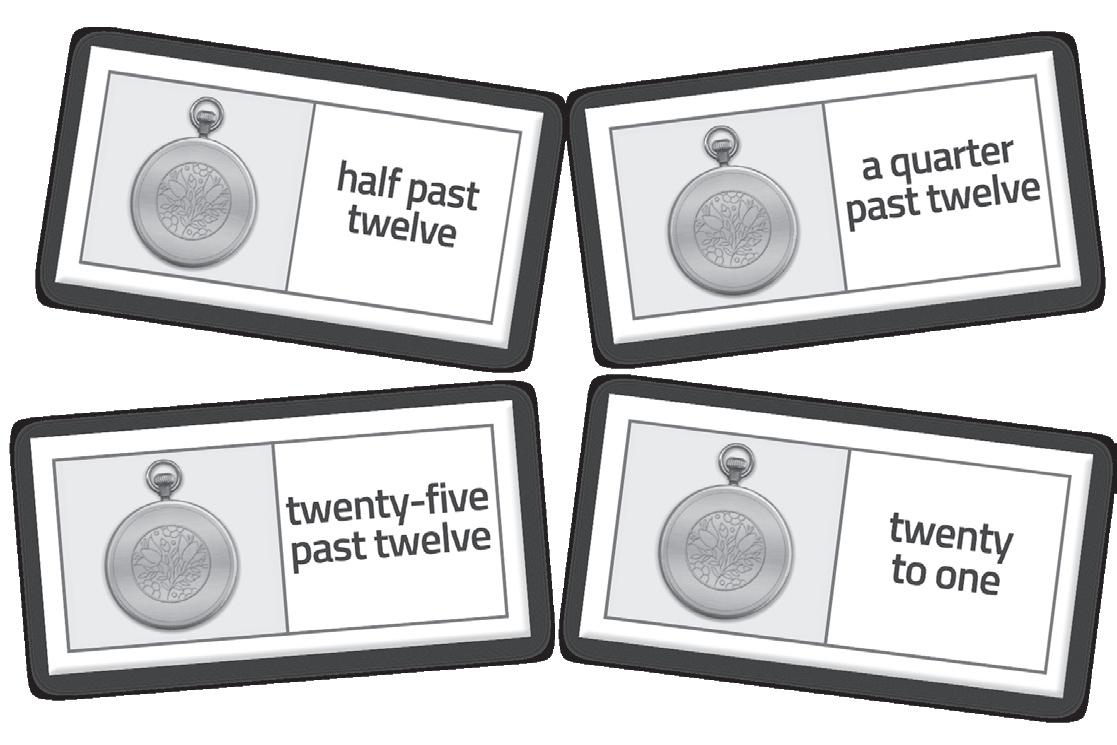Aims of the game
Time dominoes is a simple and effective game, which enables students of CEFR levels A1-A2 to quickly learn to tell the time, and ask for or give the time in English. You can have fun using it in class with the teacher or at home with your friends.


Contents
There are 48 domino cards. Each card has a clock face on the left and a written time on the right.
The cards numbered from 1 to 27 have o’clock, quarter past, half past and quarter to times on them. The subsequent cards have times with minutes on them. Cards 14 and 15/37 and 38, have blank clocks, which can be used as dominoes on two different levels: simple or complete.


Games and learning activities
Here are some suggestions for games and activities, useful for stimulating and checking the students language learning.
It is a good idea to start with a preliminary activity to check players’ knowledge and to get to know the cards, either at home or in class.
The first card, number 1, has two squares with midday and midnight on it.
Card 48 has the functional language asking for and giving the time: What time is it?


It’s… (one o’clock, two o’clock, midday, midnight, half past seven, a quarter past nine.)
Dominoes
The teacher or group leader can either suggest a simple version of dominoes using cards 1 to 27, or a complete version using all the cards (apart from cards 14 and 15). This can be done by placing card number one on the table, mixing the remaining cards and sharing them out between the players. The player with the card midday or midnight starts.
The game continues in a clockwise direction, each player placing down the card which corresponds to the clock face or the written time on the previous card. If a player is unable to do this, he/she says: “Pass”. It is then the turn of the next player. When a player lays a card down, he/she must answer the question: What time is it? The winner is the player who lays all their cards first.
Snakes and ladders
The teacher or the group leader can suggest this game after completing the game of dominoes. Divide the players into two teams, giving each team a coloured counter and placing a dice on each table.
The two teams much reach card 1, starting from the last domino card. Each team follows an opposite route: one towards middaythe other towards midnight
Players from each team take turns to throw the dice and move their counter forward according to the number on the dice: each domino card corresponds to two squares / two points. When players reach a new square they must say what the time is on the clock or read out the written time.
You can apply penalties or rewards, depending on the amount of time available to play. The team that reaches card number 1 first, wins.
True or false?
The teacher or the group leader places a domino card on the table, and referring to the illustrated clock faces, says a time out loud. The two teams must decide as quickly as possible if the time is correct or not.


If it corresponds to the clock face the team shouts: “True!” and repeats the time. If it does not correspond, the team shouts: “False!” and corrects the time.
In either case, the team that gives the correct answer quickest, wins the card. The team with the most cards at the end wins the game.
Let me see!
In this game you can choose to play with the right or the left half of the card.
The teacher or the group leader forms two teams with an equal number of players and gives each player 3 or 4 cards. The two teams sit opposite each other. Each player quickly shows his/her cards to the player opposite at the start of the game.
Player A asks player B: What time is it? Player B chooses a card and places it face down on the table and replies, for example: It’s a quarter past nine.

Player A asks to see his/her opponent’s card: if the time corresponds, player B keeps his/her card and takes a card from player A; but if it doesn’t correspond, player B loses the card and must give it to player A.
Player B then asks the same question to player A, following the same rules

Half past seven.
The game can be played by several pairs at the same time, or by one pair at a time. The team with the most cards at the end wins the game.
False! True!
Half past five.
Naturally, these are only some suggestions for activities you can do with the Time Dominoes Teachers should make best use of the cards according to initial class language levels and specific learning objectives. They can also add to or enhance these learning activities as they wish, in order to stimulate students to learn English.
Time Dominoes
by Joy Olivier© 2019 ELI s.r.l. P.O. Box 6 – 62019 Recanati – Italy
Tel. +39 071 750 701 – Fax +39 071 977 851 www.elionline.com - www.elilanguagegames.com

English version: Catrin E. Morris
Art Director: Letizia Pigini
Editorial Department: Gigliola Capodaglio
Production Manager: Francesco Capitano
Illustrations, graphics project and layout: Studio Cornell
Printed in Italy by Tecnostampa Pigini Group Printing Division – Loreto -Trevi
ISBN 978-88-536-2812-1
No unauthorised photocopying. All rights reserved. No part of this publication may be reproduced, stored in a retrieval system, or transmitted, in any form or by any means, electronic, mechanical, photocopying, recording or otherwise, without prior written permission of ELI.

